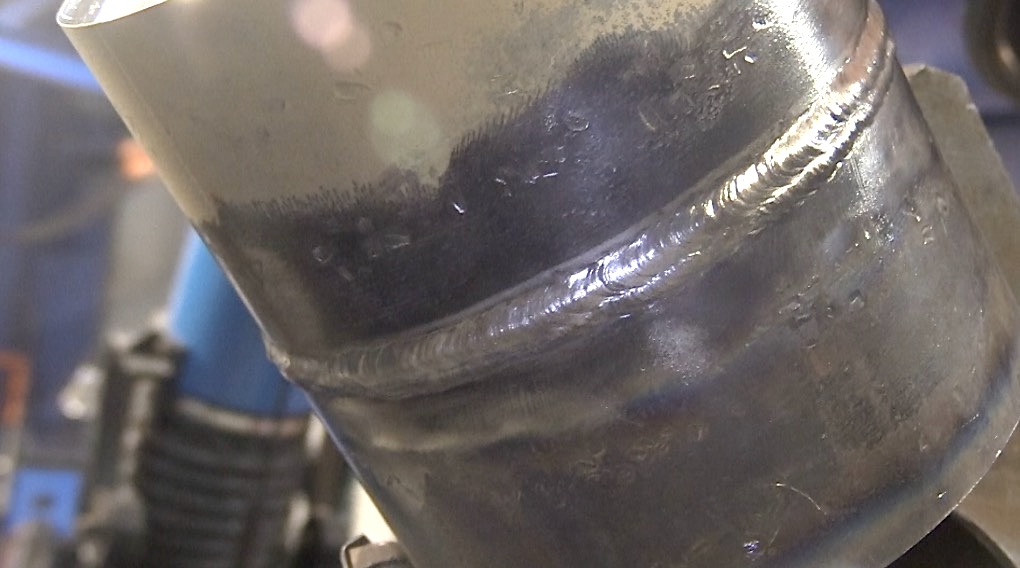Tips for Passing a 6g Pipe Welding test 6010 root pass
scroll down for videos

- HOME
- STICK WELDING
- Pipe Welding
The video below is from 2013 but still offers a different perspective using different welding machines
The UA-28 pipe welding test is a 6 inch schedule 80 pipe done in 6g postion using a 6010 for root pass and a 7018 fill and cap.
This video is strictly about the root pass...
...but coming soon will be 1 or 2 more videos on fill and cap using 7018...probably a 3/32" hot pass, and 1/8" fill and cap.
The test spec I read ... the ua-28 pipe welding test provided for a 0-1/8" land(0-3mm), a 1/16" to 1/8" gap (1.6-3mm) , a 1/16" (1.6mm) maximum mismatch, and a 75-100 amp range for the 6010 1/8" (3mm) electrode root pass.
Fitup makes all the difference on this as well as most welding tests.
For example, A tight gap requires more amperage and a wide gap requires less amperage. Same goes for the land... A heavy 1/8" land allows for more amperage than a 1/16" land. Amperage needs can differ by as much as 25 amps depending on fitup. So if you practiced using a certain setup, make sure to use the exact setup on the test.
Personally, I prefer a land between 3/32" and 1/8" with a 3/32" gap.
That allows me to use around 80 amps which is enough to start on a tack without sticking,....but its not so hot that the keyhole gets out of hand.
I also found that the type of welding machine used makes huge difference . Some machines have arc control also known as the "dig" function and for 6010 rods, the manufacturer recommends setting the arc force or dig high.
But I found that setting the arc force on high did not always work best.
These days, Not all welders will even burn a 6010 rod.
AC welders wont, and a lot of low end inverter welders dont burn 6010 very well at all...But I do have a few that will.
So I welded this root using a Miller Dynasty and also a Lincoln Powermig 350mp.
I had decent results setting dig to 50 on the miller dynasty 200dx.
But for welding the root with a Lincoln powermig 350mp.(multi process mig, tig, stick) a lower arc control setting seemed to work better.
I dont know why but I do know that it has something to do with the volt/amp curve and how the machines are designed to respond to changes in arc length/voltage.
...and 80 amps on one machine was definitely not the same as the other ...depending on where I set the arc force.
Pipeliners and rig welders often swear by the old lincoln sa200 redface machines and even particular years and models are reported to make a huge difference for 6010 root pass welding.
Thats all fine, but most often, when you go to take a pipe welding test, you are required to use whatever machine the test facility provides.
So if you are practicing for a 6g welding test like this, you would be wise to use a few different machines so you will be able to make adjustments on the fly if you need to.
Here are a few tips for increasing your chances:
- Ask the test supervisor ahead of time about anything you are unsure of like time limits, grinding, amperage limits, welding procedure specification, etc.
- Make sure to have as little mismatch ( aka hi-lo) as possible.
make sure the gap is as even as possible all the way around. - pay attention to the tack welds to determine if amperage seems
good...remember that welding in the 6g position is almost like vertical
uphill and requires slightly less amps than horizontal.
feather tacks with a grinder to ensure good tie ins. - hold the rod in the electrode holder in such a way that allows you to maintain a favorable angle as you progress the weld uphill.
- aim for the center of the pipe with the rod ( this will keep the rod angle ok for the most part)
- as you tie into a previous tack, push the keyhole well into the tack until it fills.
Sometimes pipe root passes are welded downhill. In fact a lot of downhill welding is done on pipelines under the API welding codes.
But the ua-28 pipe welding test is all uphill welding. Both the 6010 root pass and the 7018 fill and cover pass are uphill and welding anything downhill on this test is grounds for failure.
see more on pipe welding

















